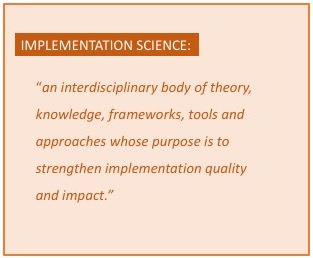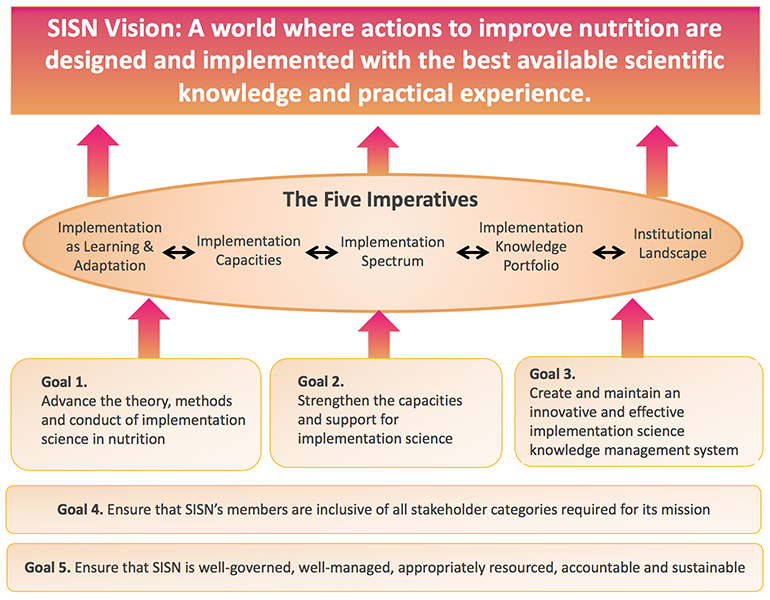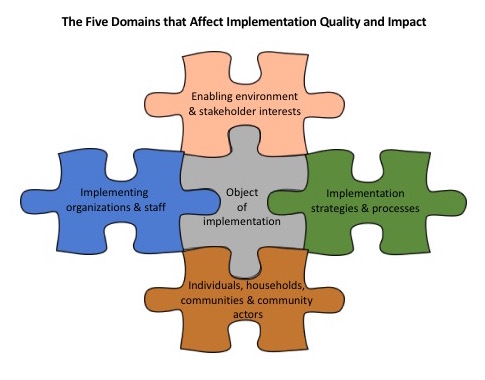The Many Forms and Purposes of Implementation Research in Nutrition: Definitions, Domains and Distinctions for Advancing Research and Practice
Poor nutrition is recognized as the biggest risk factor for morbidity and mortality worldwide. Over the past decade there has been increasing momentum within the global community to commit to “ending malnutrition in all its forms by 2030”[i]. Despite this unprecedented commitment, the Global Nutrition Report [ii] observed considerable variation in coverage across various interventions, as well as within and between countries. This demonstrates the persistent and significant gaps between global targets and actual achievements. Furthermore, the poor quality and coverage of the data itself hinders efforts to assess progress and establish accountability.
To some degree these gaps highlight a significant imbalance in research agendas. It is estimated that implementation of existing, proven interventions could reduce stunting by 36%[iii] and child mortality by 62% [iv]. However, current research agendas have focused on mechanistic research and development of new technologies with only 3% of funding devoted to improving the delivery of existing interventions[v]. Not surprisingly, investigators in the 2008 Lancet series noted that the vast majority of papers available for review were based on small-scale efficacy studies with only 3% focused on large-scale delivery efforts [vi].
Together these observations highlight the profound challenge of translating the current evidence base, and the collective will, into high quality and sustainable implementation and impact at-scale. It is not enough to know that a nutrition intervention is efficacious; it is also necessary to identify and address barriers and enablers of effectiveness under large-scale, real-world conditions. Awareness of this need has stimulated interest in implementation science (IS) and also led to the founding of SISN.
IS offers an opportunity for multiple stakeholders to engage in collaborative and sustainable efforts to advance our understanding of how interventions can work in ‘real-world’ settings. To that end it is important that the nutrition communities at global and country levels develop a shared understanding of the scope and breadth of decisions and processes that make up and affect ‘implementation’; the diverse forms of ‘implementation research’ (IR) that can inform and strengthen implementation; and the even broader and more immediate ways in which ‘implementation science’ can inform and strengthen implementation.
Implementation
Simply put, this involves “systematic and planned efforts within a system (or organization) to introduce and institutionalize a policy, plan, program, intervention, guideline, innovation or practice and ensure its intended effects and impacts.” Taking this a step further, and building on some seminal reviews in the literature, SISN is embracing the view that implementation quality and impact is affected by the characteristics of, and fit among, five domains:
- The object of implementation (e.g. a supplement versus a multisectoral program)
- The implementing organizations and staff (e.g. an NGO versus a ministry of health)
- The broader enabling environment and stakeholder interests and dynamics
- The individuals, households, communities and community actors
- Implementation strategies and processes (e.g. private sector versus health clinics).
These five domains represent a ‘framework’ that can guide implementation itself as well as various forms of implementation research to identify and address weaknesses.
Implementation Research
In order for implementation efforts to succeed we need to strengthen the commitment, capacity and practice to systematically ‘assess and address’ potential weaknesses within and between each of these five domains. In broad terms such weaknesses could exist or arise in four broad functional areas, specifically during:
- Initiation and scoping of intervention, implementation and partnership possibilities;
- Planning of implementation inputs, activities and strategies in greater detail;
- Implementation, iterative improvement and scaling up at field level;
- Commitment, support, financing and sustainability, as part of the enabling environment.
IR can take many forms, depending on which of the five implementation domains or four functional areas is of concern. For instance, IR could take the form of rigorous evaluation of pilot or larger-scale implementation trials, with or without comparison groups and with or without randomization at household or community level. This is an important and underfunded form of IR, but involves long timelines and answers only certain implementation questions. A broader family of research methods is needed to ‘assess and address’ the wide range of weaknesses that may exist within and between the five domains and four functional areas. This includes, for example, stakeholder analysis, opinion leader research, formative research, rapid assessments, operations research, special studies, process evaluation, costing studies, Delphi studies and various forms of quality improvement or quality assurance. In other words, ’implementation research’ is an umbrella term that is defined on the basis of its purpose (i.e. to inform specific implementation-relevant decisions and processes) and is flexible and eclectic in its methods, depending on the questions and the context.
Implementation Science
IS is a broader concept (than IR) and is perhaps the most practical and immediately useful source of knowledge for strengthening implementation. For SISN’s purposes, IS (or “the science of implementation”) is defined as “an interdisciplinary body of theory, knowledge, frameworks, tools and approaches whose purpose is to strengthen implementation quality and impact.”
There are several important implications of this definition:
- A great deal is already known about implementation, such that many of the most common mistakes could be prevented by applying current knowledge rather than undertaking new investigations;
- Much of this current knowledge has already been packaged into practical tools, frameworks and guidelines that can be adapted and used in a variety of settings;
- The greatest ‘gap’ lies in knowledge utilization, rather than in generating new knowledge. This knowledge utilization gap exists in nutrition, health, education and most other sectors, and it exists in high-income countries as well as low- and middle-income countries;
- The most urgent need in nutrition implementation is to close this knowledge utilization gap by making these practical tools, frameworks and guidelines more readily accessible, through various forms of capacity building, technical assistance, coaching, knowledge brokering and dissemination.
Contextual Knowledge, Experience and Adaptation
In addition to the knowledge utilization gap one of the most difficult challenge being discussed in the IS literature relates to ‘contextual adaptation’. Contextual adaptation is needed for interventions themselves (e.g. behaviour change communication (BCC) messages and package design for micronutrient powders, implementation strategies (e.g. the duration and design of training programs for frontline workers), capacity building modalities for national staff (e.g. the form, frequency and intensity of technical assistance), frameworks and tools (e.g. national capacity assessment frameworks and quality improvement approaches) and many other functions. The literature is clear that such adaptation is necessary. The difficulties lie in two areas: deciding how much adaptation is possible before the evidence-based intervention or strategy or principle loses its quality and effectiveness (e.g. how much can the duration or intensity of frontline worker training or infant and young child feeding (IYCF) counseling be reduced without compromising quality and effectiveness?); and how, in practical terms, can implementers and other actors with relevant contextual knowledge and experience collaborate with researchers or knowledge brokers to make these critically important adaptation decisions? The adaptation challenge is one of the many reasons why the IS literature emphasizes the need for such collaboration and why SISN membership includes both researchers and implementers.
Building a Science of Implementation in Nutrition
 The SISN approach and strategic plan is based on the above concepts and a number of other themes in the literature. SISN’s overarching framework consists of five goals (and associated strategies) that address five imperatives for achieving the vision of “a world where actions to improve nutrition are designed and implemented with the best available scientific knowledge and practical experience” (Figure 1). A description of our conceptual thinking supporting this framework was presented in our previous newsletter lead article “Leveraging Change: SISN’s Key Priorities” and is outlined in our Strategic Plan.
The SISN approach and strategic plan is based on the above concepts and a number of other themes in the literature. SISN’s overarching framework consists of five goals (and associated strategies) that address five imperatives for achieving the vision of “a world where actions to improve nutrition are designed and implemented with the best available scientific knowledge and practical experience” (Figure 1). A description of our conceptual thinking supporting this framework was presented in our previous newsletter lead article “Leveraging Change: SISN’s Key Priorities” and is outlined in our Strategic Plan.
The first goal of SISN’s Strategic Plan is to “Advance the Theory, Methods and Conduct of Implementation Science in Nutrition”. To that end, one important element of that framework is a typology for distinguishing among the many different forms and purposes of IR, taking account of the various domains, functional areas and objects of implementation described in this article. It is hoped that the application of this typology will help advance the methods, conduct and capacities for IR and the accumulation of implementation knowledge over time. I will be following up on this article in a few weeks with a webcast exploring the typology in more detail. Over the coming months, we will be sharing a series of webcasts and blogs describing specific case studies as a set of examples that more clearly illustrate the focus and methods of research in the various cells of the typology. In addition, the typology will be used as the basis for a future knowledge management system, as well as in an upcoming collaborative project with the SUN secretariat. The typology will be revised and refined on the basis of these experiences.
As we move through this process, SISN welcomes participation and feedback from its members regarding our strategic plan, our frameworks and constructs, the typology and the illustrative case studies. We especially welcome additional case studies, exemplars or experiences that could illustrate additional research methods and/or strategies for closing the knowledge utilization gap.
If you have materials that you feel might be suitable or wish to contact us relating to any of our activities you can email us at implementnutrition@gmail.org. You can also comment on activities via Twitter and LinkedIn.
[ii] International Food Policy Research Institute. Global Nutrition Report 2016: From Promise to Impact – Ending Malnutrition by 2030. Available from: http://globalnutritionreport.org/the-report/
[iii] Bhutta ZA, Ahmed T, Black RE, Cousens S, Dewey K, Giugliani E, Haider BA, Kirkwood B, Morris SS, Sachdev HP, Shekar M; Maternal and Child Undernutrition Study Group. What works? Interventions for maternal and child undernutrition and survival. Lancet. 2008 Feb 2;371(9610):417-40. Available from: http://www.thelancet.com/journals/lancet/article/PIIS0140-6736(07)61693-6/fulltext
[iv] Jones G, Steketee RW, Black RE, Bhutta ZA, Morris SS; Bellagio Child Survival Study Group. How many child deaths can we prevent this year? Lancet. 2003 Jul 5;362(9377):65-71. Available from: http://www.thelancet.com/journals/lancet/article/PIIS0140-6736(03)13811-1/fulltext
[v] Leroy JL, Habicht JP, Pelto G, Bertozzi SM. Current priorities in health research funding and lack of impact on the number of child deaths per year. Am J Public Health. 2007;97:219–223. Available from: http://ajph.aphapublications.org/doi/abs/10.2105/AJPH.2005.083287
[vi] Horton R Maternal and child undernutrition: an urgent opportunity Lancet 2008 Volume 371 (9608) 179 Available from: http://www.thelancet.com/series/maternal-and-child-undernutrition

